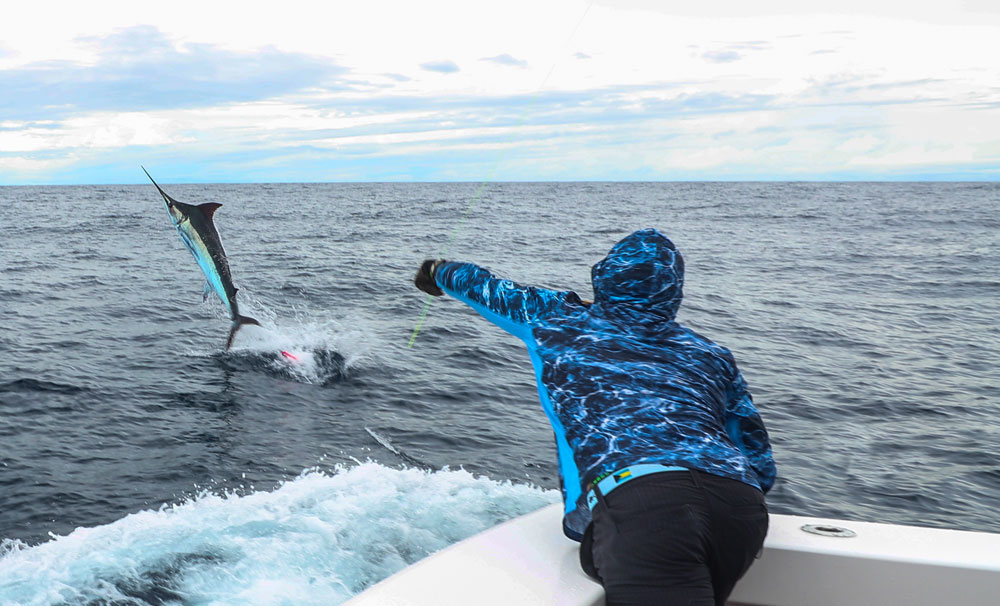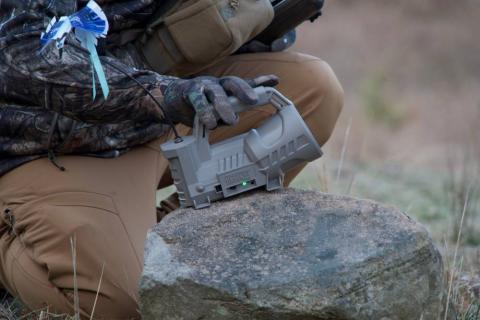with Mark Davis

As I’ve mentioned earlier, Tropic Star Lodge has the most IGFA records caught there than anywhere else. Another of the lodge’s claim to fame is that the lodge there pioneered the use of bridling live baits to catch marlin. The anglers at the lodge still pull plastic baits, but the lodge is known more for pulling live baits for marlin.
We take a piece of floss and run it through the back side of the baitfish we’ll be trolling with for blue marlin. Then we put a circle hook with the tip pointed up on top of the bait’s head and twist up the leader. Primarily we fish with bonito or yellowfin tuna that weigh from 5-15 pounds each. The circle hook resembles a horn on top of the bait’s head. This rig causes the eye and the hook to stick-up above the bait’s head. We rig this way because we want to allow the marlin to eat the bait and swallow it. Then the circle hook goes into the marlin’s stomach. When you put tension on the line, the circle hook comes back out of the marlin’s stomach and moves into the marlin’s mouth. Then when the marlin turns, the circle hook will catch on the hinge of the marlin’s jaw and make a solid hook set.
The biggest marlin I’ve ever caught weighed between 500-600 pounds. The only way to actually know the weight of a blue marlin is to kill the fish, and we don’t do that. There are tournaments where the angler must bring in a dead marlin and actually have it weighed. But none of us at “BigWater Adventures” ever have killed a blue marlin or any other billfish species, except for swordfish because they’re delicious to eat. We don’t even take the billfish we catch out of the water.
If we’re black marlin fishing, we‘ll usually fish around Zane Grey Island, a big reef that rises up from a deep bottom to about 220 feet. The water there is generally fairly clean. We usually circle the ridges coming up off the bottom, since they concentrate bait fish. Black marlin like to hang around reefs and usually hold on these reefs from one hour to one week.
But when we’re hunting blue marlin, we’ll troll along the edges of water-temperature breaks, water-color changes or the riffs. We put out live yellowfin tuna – generally two to three of these baits - and troll them along these breaks using 50 and 80-class International tackle. The captain keeps the boat moving just fast enough to keep the tuna happy and swimming. If the boat slows down, the tuna tend to cross back and forth over your lines. If the boat moves too quickly, the boat will be dragging the baits, and the tuna won’t remain alive for long. I think the boat’s running about 2-3 knots is the best.
Depending on the size of the bait, we’ll use from a No. 10/0 to a No. 16/0 circle hook. If you’re watching the line, you can see the line start to twitch and jump when a marlin comes up behind your bait. That’s when the bait may come up to the surface. We have had strikes before where the yellowfin tuna we’re using for bait has jumped out of the water trying to get away from a hungry blue marlin. If the marlin jumps out of the water and misses the bait, generally there will be huge splash. Then the marlin often will circle, come back and eat the bait. Once the marlin takes the bait, we’ll put the reel in free-spool to allow the marlin to swallow the bait. Depending on how the marlin has eaten the bait, you may wait 5-10 seconds before turning your star drag on your 50 or 80 International Reel and then slowly applying pressure, if the marlin is turning away or sideways to you. Then that will let the bait turn in the marlin’s stomach and start coming out of the marlin’s mouth and get hooked in the hinge of the marlin’s jaw. By the time the bait reaches that jaw hinge, you’ll usually have pushed your drag down to the strike position, which will apply from 18-20 pounds of drag on the 50 or 80-class reel. Then the fight’s on!
When the marlin feels the hook and the pressure, the fish will shake its head or jump, causing the bait to come off the hook. Catching a big blue marlin is a thrill of a lifetime.






























